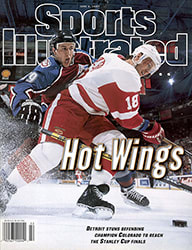
TAKE THE MONEY AND RUN MATCH RACES ARE NOTHING NEW; PASSIONS RAN HOT IN SUCH DUELS 400 YEARS AGO
The million-dollar match races this weekend between Olympic
heroes Michael Johnson and Donovan Bailey in Toronto and
Noureddine Morceli and Haile Gebrselassie in Hengelo, the
Netherlands, ostensibly to determine the world's fastest
sprinter and middle-distance runner, respectively, are being
hailed as a departure for a suffering sport. But a peek in the
history books reveals that such races are at least 400 years
old. The launchpad for the head-to-head track event is neither
the Toronto SkyDome nor the Fanny Blankers-Koen Stadium, but the
turnpikes of 16th-century England.
Such was the state of the roads in Will Shakespeare's day that
human foot messengers were often speedier than horsemen. It
didn't take wagering lords long to begin betting on the prowess
of their "footmen." By the 19th century the roads and playing
fields of Britain were packed with pedestrians (or peds), as
professional runners and race walkers were called, and their
head-to-head matches often drew more than 25,000 paying
spectators.
"Never bet on anything that can talk" runs the old gambling
adage, which is based on the premise that human performers can
be persuaded all too easily to lose. The peds didn't take much
persuading. Louis Bennett, a Native American who ran in Britain
under the name Deerfoot, was so popular with English crowds that
his backers paid opponents to lose to him. Other popular forms
of chicanery included ringing (competing in different parts of
the country under different names to fool the handicappers) and
roping (losing a couple of races in order to get a good mark in
handicaps, which were more widespread than scratch races).
In 1809 Capt. Barclay Allardice failed in two well-publicized
attempts to walk 1,000 miles in 1,000 hours. But the Scottish
landowner was only waiting for the odds against him to escalate
to 16 to 1, at which point he slapped down 1,000 guineas and won
the equivalent of more than $300,000 in today's money.
Another Scot, Alfred Downer, summed up the 19th-century
professional sprinting mentality in his book Running
Reflections: "No one who is on the job ever dreams of waiting
for the report of the pistol, or whatever the signal may be, but
has already been running some five yards when the signal is
given."
Notions of fair play were also absent after the starting signal.
When a leading amateur miler named Walter George turned pro to
race top ped Willie Cummings in 1885, George got more than he
bargained for. Cummings was adept at heel-clipping--touching an
opponent's upthrust foot from behind to throw him off stride.
The practice served Cummings well against George, and he won two
of their three races. But George learned his lesson and left
plenty of distance between himself and Cummings the following
year, winning a mile race in 4:12 3/4 (the watches of the day
timed only to quarter seconds), a time generally recognized as
the world record at that distance. The mark remained unbeaten by
amateur or pro for 29 years.
But cheating became so widespread that roping and ringing were
made criminal offenses punishable by up to six months in prison
at hard labor. It was in this era that one of the most infamous
incidents in British sporting history took place.
In 1887 the two leading sprinters of the day, Harry Hutchens and
Harry Gent, were contracted to race 120 yards at Lillie Bridge
Stadium in West London. With a packed crowd and with bookies
yelling the odds--Hutchens, having dominated pro sprinting for
years, was the marginal favorite--the athletes' backers argued
over whose loss would provoke the bigger payout. Unable to reach
a decision, backers and sprinters alike absconded, climbing over
the back wall with the gate money. The irate crowd burned down
the stadium.
Pro matches continued for at least 20 years. However the revival
of the Olympic Games and the banning of bookies from track
stadiums throughout Britain in the early years of the 20th
century cemented the shoes of the peds.
Now, after almost a century's absence, they're back, with
Johnson of the U.S. and Bailey of Canada racing 150 meters for
$1 million, and either Morceli of Algeria or Gebrselassie of
Ethiopia taking the same prize if he wins their two-mile race in
less than eight minutes. And all four runners are being hailed
as potential saviors of a sport that has again fallen on hard
times.
The fire chiefs of Toronto and Hengelo might put their brigades
on alert. There's more than one way to burn up a track.
Pat Butcher is a freelance track and field writer who lives in
North London.
B/W PHOTO: MARY EVANS PICTURE LIBRARY Fans rioted in 1887 when a London race was canceled. [Riot depicted in drawing]

